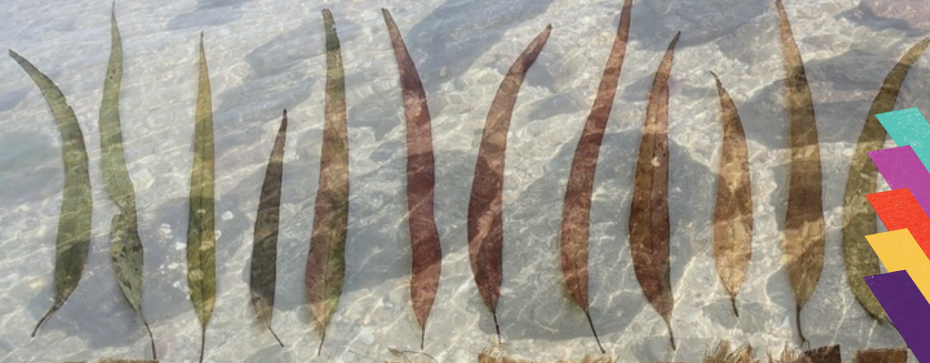
Aunty Margaret Brodie, Jennifer Eadie, Samorn Sanixay and the Kaurna Women's Art Collective
Workshop and artist talk/work-in-progress event
Before Port Adelaide was invaded, colonized, and bulldozed there was a huge sand dune system that rolled into the sea along the peninsula: breathe in the salt and then turn around so you are heading inland – you are walking amongst silver banksias – walk until your toes start to feel the earth become cooler – run your hands along the freshwater reed – let the river water wash over and under your feet – don’t you see that she is holding you? now pay attention: see this street map – it only shows one side of a story – that shoreline called Lartelare Park – it is the birthplace of Aunty Margaret’s great-great grandmother – her name is Rebecca Lartelare Spender – this river is her Country – a group of strong women standing tall and coming together, this strength could make change.
LARTELARE is a multidisciplinary and place-responsive project that focuses attention and care on Country. Acknowledging the incessant urban, industrial, and now military developments occurring across Port Adelaide, this work is a staunch rejection of this violent disregard for people and living country. The work will respond to this colonisation of place through gentle, intentional acts of resistance that will direct both process and creative work. In collaboration with weaver and textile artist Samorn Sanixay, the creative team will explore plant based dyeing techniques, weaving, and sewing with found natural and synthetic materials, to create and share a work-in-progress that incorporates textile, film, and installation.
Lead artists, Aunty Margaret Brodie and Jennifer Eadie established the Kaurna Women’s Art Collective in 2022. From their first meeting onwards, Aunty Margaret felt strongly about the need to bring Kaurna women together and believed the art project would provide a culturally safe space for this to happen. Grounded in care and respect, Aboriginal women connected to Port Adelaide have come together over 2023 to work on a series of creative projects that share story and map Country. Each collaboratively created project is motivated by their desire to protect and strengthen culture while reminding the public that the Port River is and always will be living Kaurna Country. In recognition of the strength found in collective over individual practice, the artists invite multidisciplinary collaborators to skill-share, mentor and contribute to each project.
Creative team
Kaurna Elder Aunty Margaret Brodie, Jennifer Eadie, Samorn Sanixay and the Kaurna Women’s Art Collective, including Christina Flanagan, Leona Brodie, Kizzy Flanagan, Bonny Brodie, Abbie Scarce, Emma Scarce, and Kath Butler
About the artists
Aunty Margaret Brodie is the Kaurna Elder for Port Adelaide. She is a daughter of Auntie Veronica Brodie, and great-great-granddaughter of Lartelare, a senior Kaurna woman who was born by the Port River, Kaurna Country in 1851. Over the last 10 years, as a certified Tour Guide, Margaret has shared culture and story with schools and community thru walking tours and workshops. Recently, she was involved in the Port Adelaide Enfield Council ‘Art of Reconciliation’ project (2021), ‘Bodies of Work’ (2021) and ‘Art and Culture after the Creative City’ at Vitalstatistix (2021).
Jennifer Eadie is an artist, writer, and academic living on Kaurna Country in Port Adelaide. Her creative work is interdisciplinary (text, installation, and audio-visual) but always grounded in place. Methodologically, her practice is fictocritical, involving collaboration and drawing on site-based material. Currently, she is a Research Fellow in the Nulungu Research Institute, University of Notre Dame. Her recent art and words have been shared in UNRAVEL, an on-going collaborative project with Adrianne Semmens, and in publications such as Routledge (NY), TEXT Journal and CORDITE Poetry Review. She has upcoming collaborative residencies and exhibitions at Sauerbier House Cultural Exchange and Gallery Yampu. https://jennifereadie.cargo.site/
Samorn Sanixay is a Canberra based textile designer and weaver with more than twenty years experience in textiles and natural dyeing. From 2002 to 2005, Samorn was as an apprentice under the guidance of Master weaver Khaisy Sophabmixay, who was born in Sam Neau in north eastern Laos, an area known for some of the most exquisite weavings in the world. In 2004, the Eastern Weft weaving cooperative was established to support disadvantaged young Lao artisans of ethnic minority hill tribes through traditional Lao textile crafts. In 2006, Samorn returned to Australia. The philosophy that Samorn lives by is local and seasonal, this means working in harmony with Mother Nature. Samorn works to champion the art of natural dyeing and indigenous weaving and crafts of people around the world. Eastern Weft has produced textiles for many well known fashion designers and has exhibited in Paris and Japan. In 2019, won an award for Best Supplementary Weft textiles at the ASEAN (Association of South East Asian Nations) Textile Awards. It wasn’t until moving to the foothills of Mount Majura in Canberra in 2012 that Samorn began a deep appreciation for local eucalypts and native plants. In 2022, Samorn was awarded a Dahl Fellowship from Eucalypt Australia. Her project is to create a eucalypt colour map by extracting dyes from leaves of eucalypt species collected across Australia. In each location Samorn met with Aboriginal elders and artists and shared traditional Lao dyeing techniques. Aboriginal elders shared knowledge of local plants passed down from their ancestors.
Supporters
This project is a collaboration between the artists, Vitalstatistix and OSCA, with support from the City of Port Adelaide Enfield and Arts South Australia. The Kaurna Women’s Art Collective was developed with support from an OSCA Projects of the Everyday commission.

This project is a collaboration between the artists, Vitalstatistix and OSCA, with support from the City of Port Adelaide Enfield and Arts South Australia. The Kaurna Women’s Art Collective was developed with support from an OSCA Projects of the Everyday commission.




